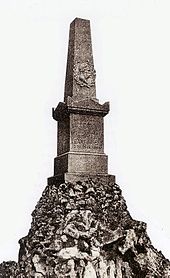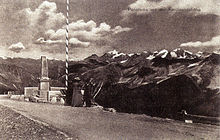Kaiser Franz Joseph Obelisk
The Kaiser-Franz-Joseph-Obelisk , briefly Emperor Obelisk , is a several-meter-high obelisk , which on the pass summit of the Stelvio Pass ( 2757 m slm ) between South Tyrol and the Province of Sondrio in the Lombardy stands. The monument, created in 1888, was originally intended to be erected in honor of Franz Joseph I on the summit of the Ortler ( 3905 m ), but this turned out to be impracticable. It is not to be confused with another obelisk on Stilfser-Joch-Straße, which was erected in 1884 by the Austrian Alpine Club in honor of the first person to climb the Ortles, Josef Pichler .
Determination as a summit sign
Originally , a stone pyramid was to be built on the summit of the Ortler, the highest mountain in the Danube monarchy . Archduke Johann of Austria had ordered this back in 1804, the year the mountain was first climbed. Construction has already begun, but after the temporary loss of South Tyrol to the Electorate of Bavaria in the Peace of Pressburg in 1805, these plans were initially obsolete. In 1888 the Ortler Committee was formed in Vienna , which set up a summit sign on the Ortler. This was to be inaugurated there to celebrate the 40th anniversary of the reign of Emperor Franz Joseph on December 2, 1888 with a bonfire and large fireworks . On this occasion the committee also wanted to expand the mountain guide system of Sulden with the help of a foundation . The plans should be funded through donations. Among the sponsors were Albert Rothschild , Crown Prince Rudolf and Johann Adolf von Schwarzenberg .
The five meter high obelisk was made from blue-gray Mauthausen granite by the imperial and royal stonemason master Eduard Hauser . On the front was a bronze plaque with the portrait of the monarch framed by laurel leaves, made by the sculptor Viktor Tilgner . The stone itself bore the inscription In memory of the fortieth anniversary of the reign of Emperor Franz Joseph I. 2. XII. 1848–1888 In addition, the names of the most generous donors were carved into a marble plaque on the obelisk. In October, the emperor granted permission to name the monument Kaiser-Franz-Joseph-Obelisk and the planned foundation Kaiser-Franz-Joseph-Jubilee-Stiftung for Austrian mountain guides and their widows and orphans , and also visited the obelisk personally.
Controversy
From the beginning, Alpine associations , whose help was originally counted on in erecting the monument, resisted the obelisk. Was instrumental in this Julius Meurer , Vice President of the Austrian Alpine Club and author of "Illustrirten Special Leader by the Ortler Alps" unworkable criticized repeatedly the company. In addition to transporting the heavy object to the summit in winter, he also saw problems with the foundation in the little rock available on the firn summit .
Nevertheless, the set-up has already been specifically planned and preliminary work such as marking the transport route and equipping the Payerhütte with sufficient provisions for the workers has started. The memorial was to be erected on a three-meter-high stone platform in the middle of the firn. The obelisk was transported to Meran and on to Trafoi at the foot of the Ortler, but the costs for this transport rose unexpectedly, mainly due to high personnel costs. Since the Prague section of the German and Austrian Alpine Club refused to make the Payerhütte available as a base, three additional huts had to be built as accommodation for the workers.
At the end of October, the district administration of Merano issued an official ban on further transport due to the expected dangers. This was followed by an intervention by Prime Minister Eduard Taaffe in favor of the obelisk, an appeal to the Lieutenancy in Innsbruck and finally an appeal to the Ministry of the Interior in Vienna. All these efforts were unsuccessful, however, and instead of the planned inauguration, committee member Demeter Diamantidi only raised the flag of the House of Habsburg at the Ortler summit on the throne jubilee .
Later uses
The obelisk remained in Trafoi and was dedicated by its builder Eduard Hauser in 1899 to the 50th anniversary of the throne of Emperor Franz Joseph, which was celebrated the previous year. For this purpose it was given a new inscription and placed on Ferdinandshöhe on Stilfser-Joch-Straße. When South Tyrol came to Italy after the First World War , the image of the emperor was removed and the German inscription was replaced by an Italian one, reminding of the construction of the Stilfser-Joch-Straße. In 1925 the 100th anniversary of this street was celebrated and the obelisk was moved from Ferdinandshöhe to the highest point of the pass for the occasion. The inscription was renewed again and today, in the spirit of Italian fascism, reminds of “Roman culture” and “Italian daring”.
literature
- Wolfgang Jochberger: "Kaiser Obelisk" for the Ortler . In: Wolfgang Jochberger, Südtiroler Kulturinstitut (Ed.): Ortler. The highest peak in the whole of Tyrol . Athesia, Bozen 2004, ISBN 88-8266-230-6 , p. 33-44 .
Individual evidence
- ↑ Wolfgang Pusch: Ortler - Königspitze - Zebrù . Rother, Munich 2004, ISBN 3-7633-7027-7 , pp. 32 .
- ↑ Wolfgang Jochberger: "Kaiser Obelisk" for the Ortler , p. 38
- ↑ Wolfgang Jochberger: "Kaiser Obelisk" for the Ortler , p. 34
- ↑ Wolfgang Jochberger: "Kaiser Obelisk" for the Ortler , p. 43
- ↑ Wolfgang Jochberger: Ortler: Alpine landmark and historical symbol . In: Wolfgang Jochberger, Südtiroler Kulturinstitut (Ed.): Ortler. The highest peak in the whole of Tyrol . Athesia, Bozen 2004, ISBN 88-8266-230-6 , p. 15 .
Coordinates: 46 ° 31 '43 " N , 10 ° 27' 10.7" E


